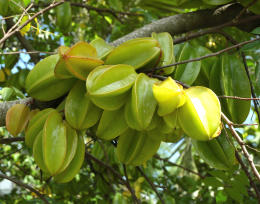|

Tropical fruits are in favor
By Urban Harvest
 For many years, Dr. Bob Randall said at classes and in his gardening and fruit tree care book that our area can grow a remarkable number of fruits and vegetables, nearly all that you have ever eaten, except perhaps cold temperate types like gooseberries and cranberries, and tropical fruits like mango, lychee, avocado, guava, pineapple and papaya. For many years, Dr. Bob Randall said at classes and in his gardening and fruit tree care book that our area can grow a remarkable number of fruits and vegetables, nearly all that you have ever eaten, except perhaps cold temperate types like gooseberries and cranberries, and tropical fruits like mango, lychee, avocado, guava, pineapple and papaya.
We still can't grow the gooseberry types, but Dr. Randall says his statement is out of date regarding the tropicals at least in the urban parts of Houston and near the coast. Seen around the Museum district are large mango fruit growing, and he has lychee fruit growing in his yard near the Southwest 610 Loop, as well as a pineapple plant that made it through December cold temperatures.
He says our Houston is not your grandmother's Houston. The main reason is climate change, although there are other factors. According to the U.S. EPA, "The eight warmest years on record (worldwide since 1850) have all occurred since 1998, with the warmest year being 2005." They add, "The warming trend is seen in both daily maximum and minimum temperatures, with minimum temperatures increasing at a faster rate than maximum temperatures."
Land areas have tended to warm faster than ocean areas and the winter months have warmed faster than summer months. Widespread reductions in the number of days below freezing occurred during the latter half of the 20th century in the United States, as well as most land areas of the Northern Hemisphere and areas of the Southern Hemisphere. (see EPA climate change science).
What this means for Houston area growers, is many things. We are likely to face a lot of unpredictable winds, rains, and temperatures, and these will impact our planning, landscapes and fruit trees, buildings as well as nearly everything else. So we really don't know what to expect. The EPA's summary though has to be our best guidance. Particularly, winter minimums will likely be among the highest on record, so as in the last decade, we are unlikely to have hard freezes in the urban and coastal areas, and perhaps the rural interior.
So it may be a good idea to gamble against the weather gods and plant some tropical fruits. It is best to plant them on the south and west sides of either buildings or tall evergreen trees. As well you can put them between two structures or trees on the east and west where the space between is half as wide as the height of the surroundings.
Alternatively, you can elect to grow them in large pots brought into a heated lighted barn (as a grower north of the city of Austin does), or you can erect a temporary plastic sheeting greenhouse or permanent one around those in the ground (as is done in Katy). You can find low temperatures for the past 10 years for your locale, or a place near it at Urban Harvest Weather data.
Although you can buy many tropical fruits over the internet, it is less expensive to buy local. Check out the 14th Annual Urban Harvest Fruit Tree Sale on January 18th, 9am - 1p.m., (or until sold out) at the Rice University Greenbriar stadium lot.
Additionally you can prepare for what you might want to purchase at the sale by attending one of the Prepare for the Fruit Tree Sale talks where the details of the varieties to be sold will be covered in complete detail.
This column is produced by Urban Harvest. Learn about gardening classes, community gardens and orchards, farmers markets and more at www.urbanharvest.org. This article was written by Bob Randall, Ph.D. who is now retired, is a co-founder and former executive director of Urban Harvest and the author of Year Round Vegetables, Fruits and Flowers for Metro-Houston. Contact him at http://yearroundgardening.wordpress.com
|
